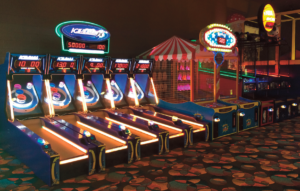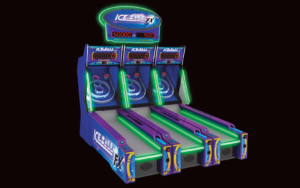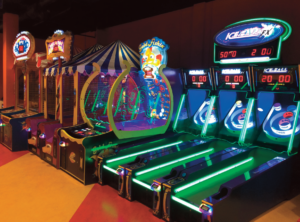Bring on the Wall
It’s been around for as long as arcades and fairgrounds, it’s simple, and some would say common sense – so what exactly is a skill wall, how do you get one, and why should you? Sega Amusement International’s General Manager Justin Burke explains the concept itself, and it is pure simplicity: “It’s not a new concept, it’s one that has existed probably since the birth of the arcade/amusement/fairground industry.
 “It’s been reinvigorated in the past four years thanks to ICE (Innovative Concepts in Entertainment, the US company working with Sega); the concept is a bank of machines and all of them are skill-orientated, aimed at the family market, games of fun and skill with traditional fairground-style concepts and games that we have seen be such big hits over the past few years. Banked together, they become an attraction and part of the location. It creates an area which is both fun and kind of old-fashioned, it’s simple interactive fun for the family.
“It’s been reinvigorated in the past four years thanks to ICE (Innovative Concepts in Entertainment, the US company working with Sega); the concept is a bank of machines and all of them are skill-orientated, aimed at the family market, games of fun and skill with traditional fairground-style concepts and games that we have seen be such big hits over the past few years. Banked together, they become an attraction and part of the location. It creates an area which is both fun and kind of old-fashioned, it’s simple interactive fun for the family.
“The idea really has been around since arcades and fairgrounds, it’s that traditional fairground ‘roll up, roll up!’- style game.”
So is it an idea that has faded away, only to be reborn on a wave of ticket waving families? Not so, says Justin. “I wouldn’t say it has fallen out of favour; I think it’s always been there in the fairground market and it has had its place in theme parks over the years. It’s just not been as strong in the coin operated arcade market. Now we’ve come full circle back to family, back to simple games in some sense, it’s a perfect match with what has always been there traditionally to what we now need and want.
“It’s really growing here. We showed the first machines four EAGs ago, then three years ago we had a skill wall and we named it as such, so people started thinking of it as a Skill Wall. We have done lots of press and advertising to support that concept too, and people now know what it is, speak to us about it and the terminology is in the industry vocabulary now.
ICE started the product and we have worked hard with them, dedicating time and marketing, trade show space to push that envelope and it is working.
Redemption
The major growth area for most venues in recent years has been redemption, and skill wall fits nicely in with that – the games that make the perfect wall are, according to ICE’s Mike Tobin, NBA Hoops basketball game, Ice Ball FX, Down The Clown, Milk Jug Toss and more. Games that, essentially, need no explanation and have no language or skill barrier to participation, and that any age can enjoy. Mike added: “They are games everyone can relate to. Even if you haven’t seen Down The Clown before you can look at it and see there’s a ball, the ball goes somewhere… People gravitate toward these games regardless of the kind of group they are in – boyfriend/girlfriend, families, it’s competitive, it’s fun, and high energy.”

Justin agrees – he says a venue is basically creating an experience for its players. “Within a venue, it becomes a part of the venue and yes, it’s an experience. You could play ten or 12 machines in a half hour, it’s different to playing one game then walking off to find the next.
“We have seen operators bank the machines and create an area with signage, carpeting, and decoration to make it more of a destination or a feature. It’s nice to see operators take this on and put their own twist on it; that can only be good.
“One company is talking about simulating a boardwalk, so recreating the old fairground boardwalk with bare wood flooring, carnival signage above, nice lighting, with the machines as the heart of it. Customers are really using their imaginations to enhance the experience.”
Mike says the experience in the US is similar, but operators have to consider how they put the wall together – and what may seem counter-intuitive initially could be one of the great strengths of the skill wall: keep machines of the same type together. Why? Competition! Mike explained: “It’s important to make sure the area has the required space and the feel to make sure people are able to engage and have fun. We’ve seen areas that are quite congested and thrown together; you want to create an environment that is conducive to a competitive atmosphere. Some people have more than one basketball game and they break them up; we recommend lining them up together, keeping games that are the same close by so that you can compete against your friends or family. It shouldn’t be an afterthought, it should be part of your layout and overall plan. Then the wall will do the work for you, you don’t have to signpost it, people will come to the games.”
90 per cent
It’s a concept that American players have grown up with and Mike says that in 90 per cent of US family entertainment centres, you will see a skill wall element. So why has it not had the same impact historically in the UK? Mike has a couple of ideas: “Every legitimate family entertainment centre and arcade in America has a component of a skill wall, to varying degrees, whether it’s a couple of basketball games and a couple of Ice Balls, or carnival games. I would say if you walk in to over 90% of locations, they will have some component of a skill wall. Typically there is a dedicated area where they have basketball, an Ice Ball, some kind of ball toss game, all together.

“Internationally it is a well-known concept but perhaps in the UK market, some locations are smaller, or have height restrictions; some of the sporting games might be more ingrained in US pop culture like a basketball, American football, just because those sports originated in the US. In the UK those sports are still gaining traction; that might be one of the reasons historically. Over the last 10-15 years those games have really become very popular over there [the UK] though.
The beauty of the skill wall for the operator is that it can be bought in parts, as quickly or as slowly as you want to, as Justin explained: “[the operator] can start with just a couple of machines, then the next year they can add a couple more, now they’ve got four machines, say, and before you know it they have a skill wall. You don’t have to buy it in a year for any kind of ‘wow!’ factor, you can build it, see what comes out the following year and what you feel like adding to it, and what you think will work for your customers.”
Skill wall is here, it’s growing, and the reasons are so wonderfully simple: it’s easy to build, you can add to it at your own pace (even over a period of years) and the players love it. So what are you waiting for?
